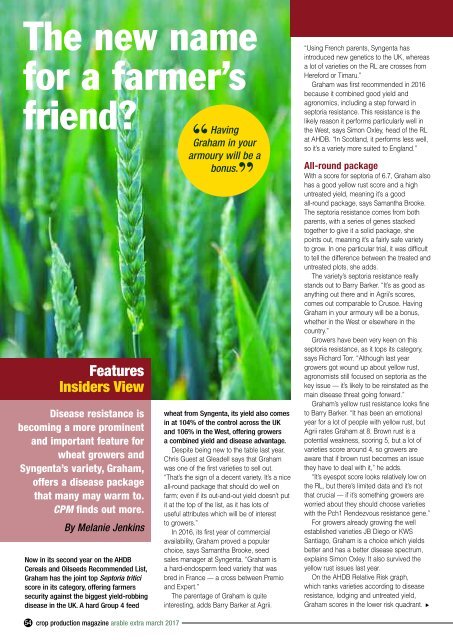In this issue..
CPM-March-Extra-2017
CPM-March-Extra-2017
Create successful ePaper yourself
Turn your PDF publications into a flip-book with our unique Google optimized e-Paper software.
The new name<br />
for a farmer’s<br />
friend?<br />
Features<br />
<strong>In</strong>siders View<br />
Disease resistance is<br />
becoming a more prominent<br />
and important feature for<br />
wheat growers and<br />
Syngenta’s variety, Graham,<br />
offers a disease package<br />
that many may warm to.<br />
CPM finds out more.<br />
By Melanie Jenkins<br />
Now in its second year on the AHDB<br />
Cereals and Oilseeds Recommended List,<br />
Graham has the joint top Septoria tritici<br />
score in its category, offering farmers<br />
security against the biggest yield-robbing<br />
disease in the UK. A hard Group 4 feed<br />
“<br />
Having<br />
Graham in your<br />
armoury will be a<br />
bonus. ”<br />
wheat from Syngenta, its yield also comes<br />
in at 104% of the control across the UK<br />
and 106% in the West, offering growers<br />
a combined yield and disease advantage.<br />
Despite being new to the table last year,<br />
Chris Guest at Gleadell says that Graham<br />
was one of the first varieties to sell out.<br />
“That’s the sign of a decent variety. It’s a nice<br />
all-round package that should do well on<br />
farm; even if its out-and-out yield doesn’t put<br />
it at the top of the list, as it has lots of<br />
useful attributes which will be of interest<br />
to growers.”<br />
<strong>In</strong> 2016, its first year of commercial<br />
availability, Graham proved a popular<br />
choice, says Samantha Brooke, seed<br />
sales manager at Syngenta. “Graham is<br />
a hard-endosperm feed variety that was<br />
bred in France –– a cross between Premio<br />
and Expert.”<br />
The parentage of Graham is quite<br />
interesting, adds Barry Barker at Agrii.<br />
“Using French parents, Syngenta has<br />
introduced new genetics to the UK, whereas<br />
a lot of varieties on the RL are crosses from<br />
Hereford or Timaru.”<br />
Graham was first recommended in 2016<br />
because it combined good yield and<br />
agronomics, including a step forward in<br />
septoria resistance. This resistance is the<br />
likely reason it performs particularly well in<br />
the West, says Simon Oxley, head of the RL<br />
at AHDB. “<strong>In</strong> Scotland, it performs less well,<br />
so it’s a variety more suited to England.”<br />
All-round package<br />
With a score for septoria of 6.7, Graham also<br />
has a good yellow rust score and a high<br />
untreated yield, meaning it’s a good<br />
all-round package, says Samantha Brooke.<br />
The septoria resistance comes from both<br />
parents, with a series of genes stacked<br />
together to give it a solid package, she<br />
points out, meaning it’s a fairly safe variety<br />
to grow. <strong>In</strong> one particular trial, it was difficult<br />
to tell the difference between the treated and<br />
untreated plots, she adds.<br />
The variety’s septoria resistance really<br />
stands out to Barry Barker. “It’s as good as<br />
anything out there and in Agrii’s scores,<br />
comes out comparable to Crusoe. Having<br />
Graham in your armoury will be a bonus,<br />
whether in the West or elsewhere in the<br />
country.”<br />
Growers have been very keen on <strong>this</strong><br />
septoria resistance, as it tops its category,<br />
says Richard Torr. “Although last year<br />
growers got wound up about yellow rust,<br />
agronomists still focused on septoria as the<br />
key <strong>issue</strong> –– it’s likely to be reinstated as the<br />
main disease threat going forward.”<br />
Graham’s yellow rust resistance looks fine<br />
to Barry Barker. “It has been an emotional<br />
year for a lot of people with yellow rust, but<br />
Agrii rates Graham at 8. Brown rust is a<br />
potential weakness, scoring 5, but a lot of<br />
varieties score around 4, so growers are<br />
aware that if brown rust becomes an <strong>issue</strong><br />
they have to deal with it,” he adds.<br />
“It’s eyespot score looks relatively low on<br />
the RL, but there’s limited data and it’s not<br />
that crucial –– if it’s something growers are<br />
worried about they should choose varieties<br />
with the Pch1 Rendezvous resistance gene.”<br />
For growers already growing the well<br />
established varieties JB Diego or KWS<br />
Santiago, Graham is a choice which yields<br />
better and has a better disease spectrum,<br />
explains Simon Oxley. It also survived the<br />
yellow rust <strong>issue</strong>s last year.<br />
On the AHDB Relative Risk graph,<br />
which ranks varieties according to disease<br />
resistance, lodging and untreated yield,<br />
Graham scores in the lower risk quadrant.<br />
▲<br />
54 crop production magazine arable extra march 2017


